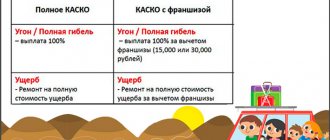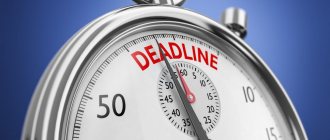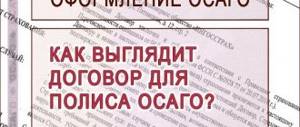The concept “CASCO” refers to the procedure for insuring any type of vehicle. A legal term used in the international insurance market.
Dear readers! The article talks about typical ways to resolve legal issues, but each case is individual. If you want to find out how to solve your particular problem , contact a consultant:
+7 (499) 938-81-90 (Moscow)
+7 (812) 467-32-77 (Saint Petersburg)
8 (800) 301-79-36 (Regions)
APPLICATIONS AND CALLS ARE ACCEPTED 24/7 and 7 days a week.
It's fast and FREE !
Motor insurance for this type is carried out on a voluntary basis. A CASCO policy purchased under an agreement concluded with an insurance company compares favorably with a compulsory motor liability insurance policy, since it allows you to receive compensation for almost any type of risk.
What applies to them
Under a CASCO agreement, the occurrence of an event obliging the insurance company to cover damage caused to vehicles may be recognized as an insured event.
The terms of coverage must be discussed in the insurance contract, which must be drawn up in compliance with certain rules and regulations of current legislation.
An insured event is determined by the risk that is included in the insurance coverage of the CASCO policy under the insurance contract.
They are divided into two groups:
- damage is manifested in the risk of damage, complete destruction of the car as a result of an emergency situation on the roads, leading to an accident. These include collisions of vehicles, their collision with each other, their overturning, falling into a ditch, ravines, collision with another vehicle when it is parked;
- theft occurs in the case of theft, robbery, illegal taking, without intent to steal.
The insurance company individually determines the risks from which types of risks it is ready to protect its clients. However, as practice shows, the set of risks is standard. It depends on the package purchased by the client, which can be either extended or reduced.
When concluding a CASCO agreement, the policyholder is given the following:
- a policy confirming the rights of the car owner;
- CASCO insurance rules, the content of which explains the procedure for action in the event of an event that can be recognized as insurance;
- a memo to the policyholder containing information about the insurance company and contact details.
First steps if you see scratches on your car
If a car owner notices damage to the paintwork on his car, then first of all there is no need to panic. Especially if the car is insured under CASCO.
Repairs to all scratches, dents and other minor damage will be paid for by the insurance company under the CASCO agreement. This will happen even if you inadvertently scratched the door when opening it or parked unsuccessfully.
How to file an insurance case under CASCO?
What to do if the insurance company does not pay for CASCO, read here.
Find out how to file a pre-trial claim with an insurance company under CASCO at the link:
If you find yourself in such a situation, then you need to perform not only the actions provided for by the Traffic Rules, but also those specified in the insurance contract.
So, here are your approximate actions after a traffic accident:
- Immediately after a collision, stop and do not move your vehicle again;
- be sure to turn on the hazard warning lights;
- do not forget to install a warning triangle at a distance of at least 15 meters from the car. This is a mandatory requirement of the rules, because if there is no such sign, then drivers of other cars may not notice you and crash into you. If you do not put up signs and do not turn on the emergency lights, then the traffic police officer who arrives at the scene will definitely draw up a protocol on the violation, and you will be held administratively liable in the form of a fine of 1,000 rubles;
- do not change the situation at the scene of the incident. If some parts fall off as a result of a collision (bumper, mirror), then they can be removed only after the accident has been recorded;
- if people were injured in the accident, then provide first aid or call an ambulance;
- roughly estimate the size of the damage and the approximate amount of damage;
- notify your insurance representative about the incident by phone;
- call the traffic police inspectors. The legislator establishes that if the accident did not cause serious consequences and the drivers do not have claims against each other, then it is not necessary to call the police; the incident can be registered in a simplified manner using the Europrotocol. However, if you have an agreement with a CASAC insurer, then you will have to call road inspectors. After all, in order to pay the compensation amount, you will have to provide the insurer with documents drawn up by a traffic police inspector;
- If you collide with a car in which there was no driver (in a parking lot), then take measures to identify it. Write down his phone number and personal information;
- Record the situation at the scene using photos and videos. Pay attention to the relative position of the cars (their registration plates should be visible), the location of road signs, the presence of traffic lights, the condition of the road surface and weather conditions;
- Together with the other participants in the incident, draw up a diagram of the accident; if you have no comments on it, then sign it. The second driver must do the same;
- Since July 1, 2015, changes have been made to the Traffic Rules, according to which, if the amount of damage received by vehicles does not exceed 50,000 rudder, then immediately after drawing up a diagram and video recording, it is necessary to clear the roadway and not interfere with other road users. If this requirement of the legislator is not fulfilled, then the traffic police officer may hold you accountable for this. The fine for such an offense is 1000 rubles;
- Try to identify witnesses and eyewitnesses of the road accident, write down their contact information. Persuade them to wait for the police and give them an explanation of what happened;
- When traffic police officers arrive at the scene, wait until they draw up a report. Read it and, if there are no comments to it, sign it; if there are any, then ask for them to be included in the protocol. Within 10 days, receive a resolution from the inspector to refuse to initiate administrative proceedings.
As you can see, no complicated actions are required from you, but if you do everything, this will help you avoid an administrative fine and correctly file a traffic accident, which will subsequently help you obtain insurance.
Insured event without an accident
The owner of a vehicle has the right to insure it against other types of risks as a result of which insured events arise related to its damage as a result of:
- fire, unauthorized combustion, uncontrollable combustion;
- explosion, regardless of the reasons;
- natural disaster caused by natural disasters. For example, earthquake, hurricane wind. To receive the due payment, you must submit to the insurance company identification documents issued by the meteorological service;
- hit by stones of various diameters, their falling, falling snow, tearing off ice;
- illegal actions committed in relation to vehicles by third parties;
- damage to the body due to involuntary exposure to animals.
Is it an insured event?
What to do if you damaged the car yourself and have CASCO insurance? This is a frequently asked question and topic on motorist forums. The case is ambiguous, and therefore requires an understanding of the legislative framework and proceedings with all the nuances.
Insured events not caused by other persons will happen quite often, so the policyholder needs to know what situations can be compensated by CASCO insurance, because compulsory motor liability insurance definitely does not work for them.
Initially, you should understand the question: is self-inflicted damage to your vehicle a reason for compensation under a comprehensive automobile insurance policy.
There is a misconception that if you insure a car under CASCO, the insurer undertakes to provide compensation for all cases without further ado.
Even the insurance agents themselves promise a guarantee of trouble-free payments, but at the same time, the terms of the contract are written as it should be in reality.
You should not reassure yourself with promises, but should start studying the legislative framework.
Comprehensive vehicle insurance, according to the Insurance Rules, provides financial protection for motorists from:
- any damage after the vehicle gets into an emergency;
- natural disasters (lightning, falling tree/hail/other solid natural objects, hurricane, fire or explosion);
- the vehicle falling under water, ice or holes in the ground;
- illegal actions of attackers;
- theft of a vehicle or theft of any of its parts.
If you read the legislation or even the rules for your comprehensive insurance contract, it will become clear that not all incidents will be compensated to the policy owner.
But damage to the vehicle by its owner can be done in different ways:
- improper parking or entry into a garage;
- driving while drunk or under the influence of other substances that interfere with adequate driving;
- falling into a ditch, under ice or into a hole on the surface of the earth.
The cases are different, but the reason for them may be the same - the actions of the driver himself. Some situations provide for compensation, but it is necessary to prove the innocence and unintentionality of the actions of the insurance policy owner.
What doesn't apply to them
Along with those classified as insurance, in practice there are often cases that the insurance company does not regard as insurance. The policyholder must have strong arguments to prove that he is right in recognizing the case by the insurance company.
Such situations are created when:
- the car at the time corresponding to the incident was driven by another person who was not included in the list of persons allowed to drive;
- the driver does not have a driver’s license, its validity period has expired, it does not indicate the required category, there is no power of attorney from the owner of the vehicle allowing him to drive the vehicle;
- the driver was drunk or under the influence of narcotic or toxic substances;
- the incident was committed under the influence of medications that are officially contraindicated when driving vehicles.
In addition to the cases listed above, these include cases committed by the driver due to negligence in driving.
These include:
- the vehicle was not put on the handbrake, as a result of which it moved, leading to damage;
- careless use of fire led to a fire inside the car;
- the movement of vehicles was carried out on territory not included in the highway;
- the fuel or brake system, steering, or engine have been changed without obtaining the appropriate permission from the traffic police;
- intentionally causing damage in order to receive payments under the CASCO agreement.
Each insurance company has the right to set individual criteria for assessing an incident for its clients in order to classify the case as insurable and make a payment in accordance with the CASCO policy.
However, the policyholder needs to more carefully study the terms of the contract and the Rules under which payment is made in order to avoid future unpleasant situations.
The CASCO Confident Driver program from the VSK company is discussed in the article: CASCO VSK. Read about the conditions of the CASCO Comfort program of the Ingosstrakh company at this link.
Is the insurer underestimating the damage?
If a situation arises in which the insurance company underestimates the damage from an accident or other incident with your car, you can contact a special certified center where independent experts conduct car inspections.
This service is provided for a fee, but the cost may be reimbursed by the insurance company. The company's client can also conduct an independent auto examination to identify hidden damage. It must be carried out at a time and place agreed upon with the insurance company, of which the inspection organizer must notify in writing by telegram.
You can present the independent expert’s conclusions to the insurance company with a request to review the decision on the amount of compensation for damage. This client right is regulated by the Bank of Russia resolution “On the procedure for calculating the cost of repairing a vehicle under a CASCO agreement.”
After the appraisal bureau makes its conclusion, you need to provide the following documents to the insurance company:
- a claim for payment of compensation within the amount specified in the CASCO insurance contract;
- a copy of the agreement with the appraisal bureau;
- report from the appraisal bureau on the amount of damage;
- justification of the amount of damage issued by the insurance company.
This package of documents is given to the insurance company employee against signature. Your copy of the inventory of papers must contain the signature of the employee and the seal of the company.
What to do if an adverse event occurs
If there has been an insured event, then it is necessary to focus on the rules and follow its requirements in order to receive the due payment without unnecessary “bureaucracy”.
In accordance with the above document it is necessary:
- immediately notify the insurance company about the insured event, provide contact details, insurance contract number, car details;
- timely submit an application to the insurance company, filled out on a special form, and attach the necessary documents to it;
- provide the damaged vehicle for inspection on the day of submission of the application, and take part in it. If it is impossible to transport the vehicle to the designated place, it is carried out in the place where the person authorized by the insurance company is located;
- As soon as possible, you must submit an application to the company where the CASCO policy was purchased. In it, describe in detail the event that occurred, ask for payment to be made in accordance with the terms of the contract, provide links to the norms of legislative acts, provisions enshrined in the Insurance Rules.
The wait for a decision made by the insurance company, according to current legislation, is 20 calendar days.
At the end of the established period, she is obliged to give a positive answer or refuse to satisfy the demands of the insured, which must be reasoned.
If there is no response from the insurance company, you will need to call the Direct Claims Adjustment Department or the hotline to find out.
What to do if your insurance claim is denied
In some cases, the insurance company refuses compensation to the owner of a damaged car due to the fact that it does not recognize the incident as an insured event. To protect your rights, you need to contact the central office and file a pre-trial claim addressed to the director of the organization, requesting a more thorough consideration of your case. In the same document it is necessary to briefly but in detail indicate all the circumstances of what happened from the accident to the moment of refusal of compensation.
Try to write the claim in a friendly tone: indicate that you consider what happened not to be the fault of the entire company, but of an individual specialist, that you are asking to look into it and that you also plan to use the services of this particular insurer in the future. Take the claim in person to the office, and ask the person receiving it to stamp the date of receipt and sign your copy.
Sample pre-trial claim for collection of insurance payments under CASCO.
If the insurer has not responded to your claim or has responded formally, then you should contact a competent lawyer specializing in auto insurance disputes. He will help you draw up a statement of claim, collect the necessary documents, and can also represent your interests in court. The cost of his services will be reimbursed to you if the court accepts your side and satisfies the claim.
Sample statement of claim for recovery of insurance payments under CASCO.
What documents are needed?
The occurrence of an insured event always occurs unexpectedly, but if it occurs, then it is necessary to take timely measures to obtain compensation.
The policyholder must submit certain documents to the insurance company, which include:
- original CASCO policy;
- a receipt or payment order certifying payment for the policy;
- if available, a copy of the act, the content of which is the inspection of the car before execution of the contract;
- passport identifying the person submitting documents for consideration;
- if the interests of the policyholder are represented by another person, then a general power of attorney to negotiate payment;
- the original certificate confirming the registration of the car with the traffic police;
- diagnostic card issued by the traffic police authority at the owner’s place of residence;
- certificates stating that the insured event occurred, depending on its type.
Basic packages of documents
The stages of drawing up a CASCO agreement include collecting and providing the insurance agent with all the necessary information about the vehicle and documentation. This is required to more accurately determine the cost of a CASCO policy. The client must provide originals and copies of the following documents:
- PTS.
- STS.
- A copy of the vehicle owner's passport (2 and 3 pages).
- Rights of all admitted persons.
- Copies of documents confirming the installation of equipment not included in the contract (if it is separately insured) and mandatory security systems and alarms.
If the vehicle is in the store at the time of concluding CASCO insurance, then a copy of the purchase and sale agreement and the transfer and acceptance certificate are added to the general package of documents. Moreover, the cost of the vehicle indicated in the contract must correspond to the amount for which the vehicle is insured in the event of theft or complete destruction. For cars purchased on credit, a bank loan agreement is also required.
IMPORTANT!!! If the package of documents provided by the policyholder is not complete, the concluded CASCO policy may not be included in the register of insurance contracts and is listed at the initial stage in the form of an application. This cannot be a reason for refusal when considering a loss, but it will complicate and delay the payment process. The client will receive funds, but only after providing the missing documents.
The stages of registration of CASCO also include the conclusion and signing of an agreement, after which the policyholder receives the following papers:
- Original insurance policy (color).
- Payment receipt.
- A brochure with the CASCO insurance rules currently in force in this company.
- A copy of the vehicle inspection report.
- One copy of the additional agreement (when accepting additionally installed equipment for insurance).
IMPORTANT!!! Be sure to make sure that all information about the policyholder, vehicle owner and car is entered into the CASCO program and policy correctly. Indeed, in the event of an error in the future, difficulties may arise with the payment of insurance compensation.
Insurance claim
Legislative acts have approved a special application form of a unified form. Usually the form is printed with the reverse side. It is filled out manually, in blue ink, legibly.
You cannot write with errors in it, because entries in the form cannot be corrected. It must be filled out correctly, without making mistakes, and following the rules.
Requirements for writing an application:
- the first column is used to describe the insured event, it contains the incoming number, the date of acceptance by the insurance company, the exact time of admission, the registration number of the policy, a note about the payment, the duration of the contract is entered, information about the presence of a franchise and the corresponding payment coefficients is recorded;
- the second column provides information about the official data of the insured, such as the year of manufacture, the assigned state number of the vehicle, its make, model, and the contact information of the company employee preparing the documents;
- the third contains information about establishing the type of insured event, describes a specific insured event that occurred with the policyholder, for example, suffered due to unlawful actions of third parties, hit an obstacle at the side of the road, for example, a parapet;
- in the fourth, the full date of the insured event that occurred is recorded, including the hour and minutes, the time the damage was discovered, and its characteristics;
- the fifth column describes the place where the incident occurred, it is necessary to note who was driving at the time of the incident, enter his personal data, indicate the presence of a driver’s license, note the expiration date;
- in the sixth, write down the information - if the driver was driving the vehicle by proxy, then it is necessary to indicate its validity period, data from the contents of the driver’s license;
If the vehicle was not being driven and no one was driving, then this fact must be noted in the application and a note should be made: “no one was driving, the car was discovered by P.P. Fedorov.”
- the seventh contains information about witnesses, their personal data, insurance policies, if there was an accident;
- the eighth must contain information about the authorities to which the insured event was reported, for example, about the Department of Internal Affairs, the State Traffic Safety Inspectorate, the Fire Service;
- in the ninth, enter a list of damages that the vehicle received.
If minor errors were made in the application during its execution, they must be corrected. Next to the correction, make a note: “believe the corrected one” and secure it with a signature.
Statement about an insured event.
In addition, a CASCO policy has benefits that guarantee coverage of some of the damage resulting from the impact of unpleasant, unforeseen events.
The insurance company will make payments in accordance with the provisions of the concluded contract, and, at the request of the policyholder, will issue an appointment to a technical center where it will repair the car.
Each policyholder, depending on his capabilities and wishes, selects an individual set of risks for himself in order to insure his vehicle.
However, we should not forget that a large number of risks increases the cost of a CASCO policy, so you need to be more careful about your actions.
You can find out what the rules of CASCO insurance apply to the Renaissance company in the article: CASCO Renaissance. Information on CASCO payments in case of an accident can be found here.
What is a CASCO deductible is described in this article.
Paying the culprit - myth or reality?
To understand how CASCO works if you are the culprit of an accident, you need to understand the mechanism of damage insurance itself.
The root cause of citizens' uncertainty about making an insurance payment to the person at fault for an accident is compulsory motor liability insurance, where compensation is due only to the injured person. However, the auto citizen does not protect the car at all, but the driver’s responsibility when driving it. Therefore, you should not apply this analogy to a CASCO policy, which protects a car from damage. It doesn’t matter who caused the accident - the owner himself or another person, the only important thing is that the vehicle was damaged, this is an insured event.
Does this mean that there is no difference for paying under CASCO if it is your fault or someone else’s? No, that doesn't mean it. An event that occurs is considered insurable only if the owner caused damage to his car through negligence. For example, I lost control and drove into a tree. If the driver intentionally crashes the car, the insurance does not work.
Additionally, the culpability of the policyholder will affect the amount of the premium when renewing the CASCO policy for the next year. If you are not at fault for the accident, the insurance company, after repairs, will recover all damages from the person causing the harm and will not incur any costs. If the car owner himself is responsible for the damage, then all expenses for it will be borne by the insurer, which will negatively affect the price of the contract upon renewal.
Period for consideration of an insured event
At the legislative level, these terms are not regulated, so insurance companies independently determine the periods during which they check the insured event under CASCO. It is advisable to specify these terms in the contract. Clear deadlines during which compensation is paid to the policyholder must also be specified.
Many companies additionally stipulate in the contract that the terms for verification of documents provided by the client and compensation for losses can be extended if the situation requires it.
In some cases, the above amendments to the contract allow insurance companies to delay the payment of compensation. In such cases, the policyholder can receive his funds only through legal means. For example, by filing a claim with the Investigative Committee or going to court (read about the limitation periods here).
Which case is considered insured under CASCO?
Even before concluding an agreement with a representative of the insurer, you should find out in detail what is included in CASCO insurance cases, so as not to be left alone with your problems in the event of damage or loss of the vehicle. Depending on the approved rules of a particular company, the following situations may be considered insurance:
- damage to the car as a result of a traffic accident, even if it was caused by the policyholder himself;
- fire or explosion of a vehicle;
- hitting an obstacle or animals;
- damage caused by natural disasters - floods, hurricanes, landslides, heavy hail, etc.;
- falling of heavy objects or objects - trees, poles, fragments of the facade or roof of buildings, icicles, etc.;
- car theft;
- constructive loss of the car, when it has received serious damage and cannot be restored;
- damage to the vehicle by large or wild animals;
- vandalism by third parties;
- damage to the car while in the parking lot.
A vehicle can get damaged in a variety of ways and for a variety of reasons.
For example, if the document states that only spontaneous combustion of a car due to faulty electrical wiring is compensated, then in case of arson no compensation will be paid. Some companies only reimburse for car theft if it was committed from a garage or secure parking lot.
Depending on the company’s rules, the policyholder may receive compensation for some damage without providing certificates from the traffic police or the Ministry of Emergency Situations. How to get insurance without an accident, or rather, without registering one, you need to ask the insurer’s manager before concluding a contract. Most often, you can do without unnecessary red tape when it comes to minor damage - dents, scratches, broken glass, etc.
What else is important to pay attention to when filing an insurance claim?
Some car owners insured under CASCO think that issuing a payment will not be difficult for them. However, there are a number of myths that mislead drivers, and as a result, unpleasant misunderstandings occur.
So, what do you need to pay attention to when you sign up for a CASCO agreement, and when you receive payment if an insured event occurs?
- Car owners believe that under CASCO their car is insured against all risks. This is absolutely not true, even if the insurance agent convinces you otherwise. It is impossible to insure against everything, since no one can predict everything that can happen to your car as a result of an accident and more. This phrase is pure marketing. But then the question arises: what exactly does this expensive policy protect the car from? As a rule, these are the most common risks: traffic accident, fire, vandalism by third parties, theft, theft, falling foreign objects, as well as adverse weather conditions (hail, hurricanes, etc.).
- I paid the insurance premium, so the insurance company must now pay me the insurance. Of course, this is true, but there is one small correction. The company will pay you compensation only if you comply with all the agreed rules that are in the contract. If you violated these rules because you forgot, did not know, got confused or did not interpret the contract correctly - these are your problems, and in this case you will not be compensated for the damage.
- If the insured event is not an accident, but, for example, damage to a car by third parties, then the police can offer you quick processing of documents and all certificates if you do not initiate a criminal case due to the insignificance of the damage. Do not agree under any circumstances - this is a direct path to the fact that the insurance company will refuse your request to issue a payment. The reason for this is that by refusing to file a criminal case, you deprive the insurance company of its right to subordination, during which it has the opportunity to recover from the third party the amount of compensation paid to you.
- Never rely entirely on insurers; when you see damage to your car, be sure to look for witnesses; perhaps a dashcam or surveillance camera was turned on somewhere. Take photos and videos of the damage, and also interview and record all the information of witnesses and eyewitnesses to the incident. Voice all your observations and conclusions to the police. And also write an application to the insurance company taking into account your conclusions.
Here's everything you need to know about getting collision-free insurance. We wish you good luck!
Registration of CASCO for a credit car
When purchasing a car on credit, the bank will be required to issue CASCO insurance for the loan vehicle, but partial insurance is not allowed and it will not be possible to save or reduce the cost of CASCO.
The bank’s demands are understandable, since in the event of a credit car theft or an accident, the bank risks suffering irreparable loss of funds. Also, a mandatory condition for lending is life and health insurance, so that in the event of loss of performance or death of the borrower, the financial institution will be compensated for the damage caused by the insurance company. List of non-insured events
It is always necessary to remember that not all insured events are subject to compensation under the CASCO agreement. For example, here are the main cases when payments are not made:
- -Causing intentional damage to the insured property
- -The insured event occurred as a result of the driver driving a vehicle in a state of alcohol or other intoxication
- - When an insured event occurred, the vehicle was driven by a driver who did not have the right to drive this vehicle
- -Use of the vehicle for training
- -The contract does not cover the territory where the insured event occurred
- - Damage caused to the vehicle during loading and unloading of the vehicle, during transportation
- -damage caused by military or similar activities
- - in case of seizure of property by court decision
- -if the car is damaged as a result of a terrorist attack
- -in case of deliberate exposure to flame
- -incorrect repair and/or installation of defective parts
- -use of the vehicle for purposes other than its intended purpose
- - malfunctions in the electrical system
- -loss of equipment not included in the factory configuration and not specified in the contract
- -if the theft occurred due to the fault of the vehicle owner
- - in case of violation of the rules for storing a vehicle










